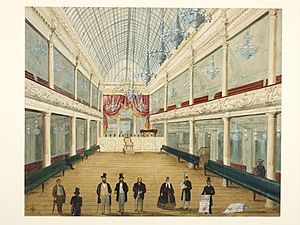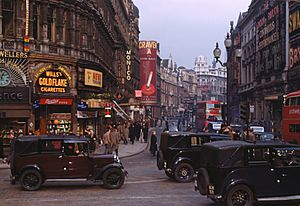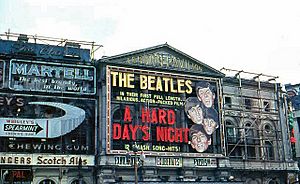London Pavilion facts for kids
|
1859 London Pavilion Music Hall
|
|

Façade of the London Pavilion in 2002
|
|
| Address | Shaftesbury Avenue Westminster, London |
|---|---|
| Coordinates | 51°30′37″N 0°08′02″W / 51.510278°N 0.133889°W |
| Owner | Burford Group |
| Designation | Grade II listed |
| Current use | Trocadero Centre |
| Construction | |
| Opened | 1859 |
| Rebuilt | 1900 & 1918 Wylson & Long 1934 converted to cinema by F Chancellor |
| Years active | 1859–1934 |
| Architect | James Ebenezer Saunders and Robert Worley (1885) |
The London Pavilion is a famous building in London, England. It stands at the corner of Shaftesbury Avenue and Coventry Street, right next to Piccadilly Circus. Today, it is a shopping area and part of the Trocadero Centre.
Contents
Early History of the London Pavilion
The first building called the London Pavilion opened in 1859. It was a music hall, which was a popular place for entertainment. People would gather to watch singers, comedians, and other performers. This first hall was made by putting a roof over the yard of an old inn called the Black Horse Inn.
In 1885, a new street called Shaftesbury Avenue was built. This meant a new London Pavilion Theatre had to be constructed. The new theatre opened on November 30, 1885. It was very fancy, with marble tables where people could eat while watching the show. This new theatre was seen as a big step forward for "variety theatre," which included many different kinds of acts. It had a beautiful outside, fancy inside, and lots of electric lights.
The 20th Century at the Pavilion
The London Pavilion became very successful. Its owner, Mr. Villiers, created a company that brought together several music halls. This was the first time music halls had joined up like this. A famous performer named Lupino Lane made his first London appearance here in 1903.
Between 1912 and 1936, the theatre mostly showed musicals. One of these was On With the Dance in 1925, which was Noël Coward's first big hit. Other famous people like Sir Harry Lauder and Clifton Webb also performed there. In 1923, bright electric billboards were put up on the side of the building for the first time.
From Theatre to Cinema
In 1934, the London Pavilion changed a lot. It was turned into a cinema, costing a lot of money. The first movie shown there was The Private Life of Don Juan in September 1934.
The cinema became famous for showing exciting films. For example, when The Curse of Frankenstein premiered in 1957, the entrance area was decorated to look like Frankenstein's laboratory! In October 1962, it hosted the premiere of Dr. No, which was the very first James Bond movie. In July 1964, it was also the place where A Hard Day's Night, a movie starring The Beatles, first showed.
The cinema closed its doors on April 26, 1981. For a few years, the building was not used much.
Becoming a Shopping Arcade
In 1986, the inside of the building was completely changed. It became a shopping arcade, but its original outside walls and roof from 1885 were kept. That same year, a wax figure exhibition called Rock Circus opened inside. It featured wax models of famous rock and pop musicians. Rock Circus closed in September 2001.
The London Pavilion Today
In 2000, the London Pavilion became part of the Trocadero Centre. In 2003, the signs on the building were changed to say "London Trocadero." The basement of the building connects to Piccadilly Circus tube station and the rest of the Trocadero Centre.
From 2008 to 2017, the London Pavilion was home to Ripley's Believe It or Not!. This was a popular place where visitors could see strange and unusual items. On October 6, 2018, a new exhibition called Body Worlds London opened there. This exhibition shows more than 200 real human bodies and organs. They are preserved using a special method called Plastination.
See also
 In Spanish: London Pavilion para niños
In Spanish: London Pavilion para niños




